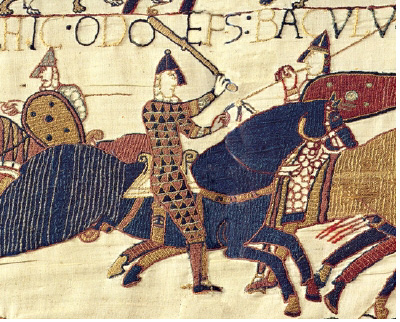...Best of Sicily presents... Best of Sicily Magazine. ... Dedicated to Sicilian art, culture, history, people, places and all things Sicilian. |
by Luigi Mendola | |||
Magazine Index Best of Sicily Arts & Culture Fashion Food & Wine History & Society About Us Travel Faqs Contact Map of Sicily
|
Born around 1030, Odo shared with William the same mother, Herleva (Arlette), who had been the mistress of William's father, Duke Robert of Normandy. Odo's father was Herluin of Conteville. William made his brother, then aged nineteen, Bishop of Bayeux in 1049; the Great Schism, a significant ecclesiastical event of the day, followed in 1054. In spite of his religious vocation, Odo assisted in the commissioning of ships for the invasion of Hastings, which took place in 1066 and changed the course of English history. In this endeavour he almost certainly had contact with knights who had been present at the Battle of Messina in 1061, the crossing of that Strait forming the tactical basis for a similar trip across the Channel. The Bayeux Tapestry - created under his episcopal authority - depicts him waving a mace (club) instead of a sword, perhaps because Church law forbade the fighting clergy (surely an oxymoron) to draw blood. Though this wartime practice made a mockery of the spirit of the law, it was as widespread during the Middle Ages as Chaucer's drunk monk. Following the success of the Conquest, William created Odo Earl of Kent in 1067. It was not an empty title. Odo ended up with twenty-three counties, mostly in East Anglia and the southeast of England. For a time he was the largest landholder in the Kingdom after William, a fact which could not have endeared him to the country's Saxon aristocracy. He functioned as effective (if unofficial) regent of England when William was away in France, and on several occasions he led royal troops against rebels, most notably during the Revolt of the Earls in 1075. While this was the last serious armed insurrection against William's authority by the nobility, the monarch would soon have to confront his brother's avarice. In 1076 Odo was put on trial for having defrauded the King and the Church, and forced to return property and other assets. Then, in 1082, he was charged, convicted and imprisoned for having planned an independent military expedition to Italy, half of which was then in Norman hands. Little is known of Odo's motives except that they greatly disturbed William, who in view of past events already questioned his brother's integrity and loyalty. It seems likely that he wanted to seize some Italian lands for himself, but some chroniclers have suggested that he sought to become Pope; perhaps he aspired to both. Another theory suggests that he intended to defend the Pope against the forces of the Holy Roman Emperor Henry IV. Odo's younger brother (also William's half-brother) persuaded a reluctant William, on his deathbed, to release the bishop in 1087, while divesting him of the County of Kent and its feudal revenue. The ensuing intrigues between William's contentious sons found Odo in Normandy in fealty to the eldest, Robert "Curthose," Duke of Normandy. With his nephew Robert, Odo "took the cross" and embarked for the First Crusade, stopping at Palermo en route. Here he visited Count Roger, the Sicilian monarch (whose son, Roger II, would make Sicily a kingdom), and died in January or February of 1097. Robert never became King of England but he did make it to Palestine, and returning to Normandy through Italy following the Crusade he wed Sybilla, a grandniece of Count Roger. Their son was the unlucky William Clito (1102-1128). It may be that the prospects of this marriage had already been discussed with Roger in Palermo in 1097 at Odo's suggestion. Odo is remembered - if at all - as being greedy, his great wealth accumulated partly through extortion and robbery, and by most accounts his vow of chastity was not taken terribly seriously. However, he was a patron of the arts and founded great abbeys, being something of an amateur but competent architect. He was interred in Palermo's Byzantine basilica but his tomb seems not to have been placed in the crypt of the Norman Cathedral of Palermo built during the following century. It is quite possible, however, that one of the large tombs there, now unmarked, was originally his.
About the Author: Historian Luigi Mendola has written for various publications, including this one. | ||
Top of Page |
 There are certain historical
figures, themselves footnotes to history rather than complete pages,
who set foot in Sicily and made their small mark on the island's heritage
only to be overlooked as inconsequential. One such personage is the colourful
Odo of Bayeux, troublesome half-brother of William the Conqueror,
England's first
There are certain historical
figures, themselves footnotes to history rather than complete pages,
who set foot in Sicily and made their small mark on the island's heritage
only to be overlooked as inconsequential. One such personage is the colourful
Odo of Bayeux, troublesome half-brother of William the Conqueror,
England's first